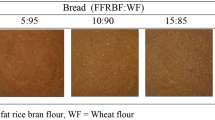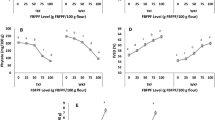Abstract
Rabadi is a cereal and buttermilk based traditional fermented recipe of western region of India. There are many traditional preparation methods, which may alter biochemical composition of rabadi, therefore, in the present study, role of traditional processings (cooking, fermentation, dehulling, utensil, preparation methods and cereals) on minerals and antinutrients of pearl millet, wheat flour and refined wheat flour rabadi was investigated on fresh weight basis. Results showed that the process of cooking and fermentation enhanced minerals (Ca, Fe and P) in all types of rabadi samples at different levels of significance, while antinutrients (phytic acid, total phenols and oxalates) reflected a declining trend. Intercomparison of different types of rabadies exhibited that fermented- cooked –fermented samples were better than cooked –fermented rabadies. Dehulling caused a loss of minerals, but antinutrients were also degraded after dehulling; therefore dehulled sample showed very good nutritional profile after fermentation. Earthen pot rabadi samples presented better biochemical composition than rabadies prepared in steel pot. Intercomparison of different cereals based rabadies reflected superior position of fermented -cooked- fermented pearl millet flour rabadi than cooked- fermented pearl millet flour rabadi, wheat and refined wheat flour rabadi samples.
Similar content being viewed by others

References
Agrahar MD, Jha K (2009) Effect of sprouting on nutritional and functional characteristic of soyabean. J Food Sci Technol 46:240–243
Akpapunam MA, Achinewhu SC (1985) Effect of cooking, germination and fermentation on the chemical composition of Nigerian cowpea (Vigna unguiculata). Plant Foods for Hum Nutr 35:353–358
Aliya S, Geervani P (1981) An assessment of the protein quality and vitamin B content of commonly used fermented products of legumes and millets. J Sci Food Agric 32:837–842
Arora S, Jood S, Khetarpaul N, Goyal R (2009) Effect of germination and probiotic fermentation on antinutrients and in vitro digestibility of starch and protein and availability of minerals from barley based food mixture. J Food Sci Technol 46:359–362
Azeke MA, Egielewa SJ, Eigbogbo MU, Ihimire IG (2011) Effect of germination on the phytase activity, phytate and total phosphorus contents of rice (Oryza sativa), maize (Zea maize), millet (Penicum miliaceum), sorghum (Sorghum bicolor) and wheat (Triticum astivum). J Food Sci Technol 48:724–729
Chaturvedi Y, Nagar R (2001) Levels of β-carotene and effects of processing on selected fruits and vegetables of the arid zone of India. Plant Foods Hum Nutr 56:127–132
Choudhary M, Das P, Baroova B (2011) Nutritional evaluation of popped and malted indigenous millet of Assam. J Food Sci Technol 48:706–711
Dave S, Yadav BK, Tarafdar JC (2008) Phytate phosphorus and mineral changes during soaking, boiling and germination of legumes and pearl millet. J Food Sci Technol 45:344–348
Dhankher N, Chauhan BM (1987) Technical note: preparation, acceptability and B vitamin content of rabadi- a fermented pearl millet food. Int J Food Sci Technol 22:173–176
Goldstein JL, Swain T (1963) Changes in tannins in ripening fruits. Phytochem 2:371–381
Gupta V, Nagar R (2008) Physico- chemical and acceptability of rabadi (a fermented soyaflour product) as affected by cooking and fermentation time. Int J Food Sci Technol 43:939–943
Gupta M, Khetarpaul N, Chauhan BM (1992) Preparation, nutritional value and acceptability of barley rabadi – an indigenous fermented food of India. Plant Foods Hum Nutr 42:351–358
Guzel D, Sayar S (2012) Effect of cooking methods on selected physicochemical and nutritional properties of barlotto bean, chicken pea, faba bean and white kidney bean. J Food Sci Technol 49:89–95
Hawk BP, Oser LB, Summerson HW (1968) Physiological chemistry. McGraw Hill Book Co, New York, p 644
Kulkarni SG, Manan JK, Agarwal MD, Shukla IC (1997) Studies on physico chemical conditions, packaging and storage of black gram and green gram wari prepared in Uttar Pradesh. J Food Sci Technol 34:119–122
Lakra P, Sehgal S (2011) Influence of processing on total and extractable mineral content of products prepared from potato flour. J Food Sci Technol 48:735–739
Luo Y, Le B, Ji H, Ji B, Ji F, Chen G, Tian F (2009) Effect of soaking and cooking on selected variety for preparation of fibrinolytic Douchi. J Food Sci Technol 46:104–108
Oboh G, Ademiluyi AO, Akindahunsi AA (2010) The effect of roasting on the nutritional and antioxidant properties of yellow and white maize varieties. Int J Food Sci Technol 45:1236–1242
Osman NM, Mohamed Ahmed IA, Babiker EE (2009) Fermentation and cooking of sicklepod (Cassia obtusifolia) leaves: changes in chemical and amino acid composition, antinutrients and protein fractions and digestibility. Int J Food Sci Technol 45:124–132
Ou K, Cheng Y, Xing Y, Li L, Nout R (2011) Phytase activity in brown rice during steeping and sprouting. J Food Sci Technol 48:598–603
Patil SB, Khan MK (2011) Germinated brown rice as a value added rice product: a review. J Food Sci Technol 48:661–673
Raghuramulu N, Nair KM, Kalyansunduram S (eds) (1983) A manual of laboratory techniques. National Institute of Nutrition, Hyderabad, pp 32–35
Soni SK, Arora JK (2000) Indian fermented foods: biotechnological approaches. In: Marwaha SS, Arora JK (eds) Food processing: Biotechnological applications. Asiatech Pub Inc, New Delhi, pp p143–p190
Vadivel V, Pugalenthi M (2008) Removal of antinutritional/toxic substances and improvement in the protein digestibility of velvet bean (Mucuna pruriens) seeds during processing. J Food Sci Technol 45:242–246
Yang H, Zhang L (2009) Changes in some components of soymilk during fermentation with the basidiomycete Ganoderma lucidum. Food Chem 112(1):1–5
Young L (1936) The determination of phytic acid. Biochem J 30:252–257
Acknowledgement
Authors are grateful to the PG Department of Home Science, University of Rajasthan, Jaipur for providing essential infrastructure to accomplish present research work in a convenient manner and to University Grants Commission to providing funds for the study.
Author information
Authors and Affiliations
Corresponding author
Rights and permissions
About this article
Cite this article
Gupta, V., Nagar, R. Minerals and antinutrients profile of rabadi after different traditional preparation methods. J Food Sci Technol 51, 1617–1621 (2014). https://doi.org/10.1007/s13197-012-0667-2
Revised:
Accepted:
Published:
Issue Date:
DOI: https://doi.org/10.1007/s13197-012-0667-2



